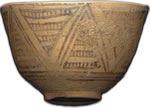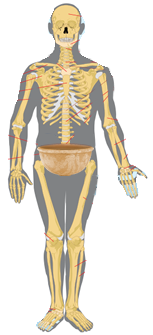Breath in the Pelvic Bowl
 In this step, we'll use imagery to focus on the breath in the abdomen, right down into the pelvis. We want to encourage the sensations in the lower part of the body, so we'll use imagery, connected with the feeling of breath action pushing into the pelvis to anchor breath as low in the torso as we can go.
In this step, we'll use imagery to focus on the breath in the abdomen, right down into the pelvis. We want to encourage the sensations in the lower part of the body, so we'll use imagery, connected with the feeling of breath action pushing into the pelvis to anchor breath as low in the torso as we can go.
Please note that the air we breathe cannot go any lower in the body than the bottom of the lungs. However, the sensation of downward pressure caused by the breath displacing your guts in a downward action can go as low as the bottom of the pelvis, and press into the muscles of the pelvic floor.
For this exercise, I'd like you to imagine that your pelvis, which is, in many ways, shaped like a bowl, has been replaced with an actual bowl, like the one in the image at the beginning of this post. Imagine a terra cotta bowl, rough on the outside, and dark and encrusted with years of dirt on the inside.
 [Though you can do this warm-up step either standing or lying down, it's important to visualize the "bowl" oriented correctly regardless of how you are positioned. I've doctored a photo to show you an image of a skeleton with the pelvis replaced with a bowl, so you see what I mean. You'll use this image in this exercise and the next step in the warm-up, so it's really important to get this image clear and strong in your mind's eye.]
[Though you can do this warm-up step either standing or lying down, it's important to visualize the "bowl" oriented correctly regardless of how you are positioned. I've doctored a photo to show you an image of a skeleton with the pelvis replaced with a bowl, so you see what I mean. You'll use this image in this exercise and the next step in the warm-up, so it's really important to get this image clear and strong in your mind's eye.]
Once you have an idea what I mean for this bowl image, close your eyes and try to imagine that your boney bowl of your pelvis is a ceramic bowl. Touch your actual hip crests, and feel the way around to the back, imagining that you’re feeling around the rim of a big bowl. With each breath, allow your breath to press down into the bowl, so that you can connect the image with the sensation of breath action in your lower body.
Imagine that the inside of your bowl is encrusted with loose dirt that you can begin to brush out of your bowl with the action of your breath. With each breath inward, swirl the brush-like action of the breath around the inside of your bowl, and then with each exhalation, breathe the dirt out along with the air. Draw in clear air to brush the inside of the bowl, and blow out dirty air to clean the rough, flaky dry dirt off the inside of your bowl.
As you clear the bowl, let the air begin to act like a little tornado or whirlwind inside you, curling its way around the bowl, getting all of the inside surfaces of the bowl, pressing into all the nooks and crannies of your pelvis. As you exhale the dirt, experiment with letting the swirling air go in the opposite direction. As you get full of air, the swirling will slow down and eventually stop, let the air change direction, speed up and pour out of you.
At this point, imagine that you can now see the surface of the inside of your bowl. Though it is a rough, terra cotta bowl on the outside, the inside of this bowl, of your special bowl, is lined with tarnished silver. Imagine that the inside of the bowl is black with tarnish, but that you can see glimpses of the potential for this bowl to shine coming through the blackness.
Our next step, "Voice in the Pelvic Bowl," will take you further with this image, as we polish the tarnish away and then let the bowl ring out with open sound. For now, brushing the inside of the bowl, and getting that image very strong, is enough.
Next Step: Voice in the Pelvic Bowl